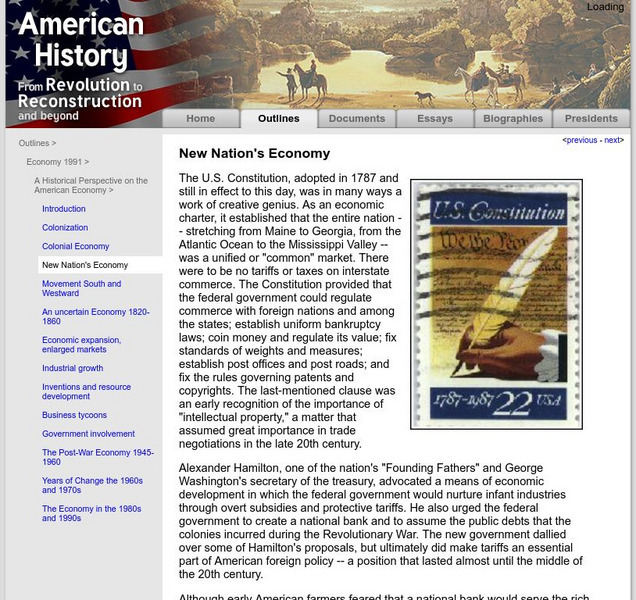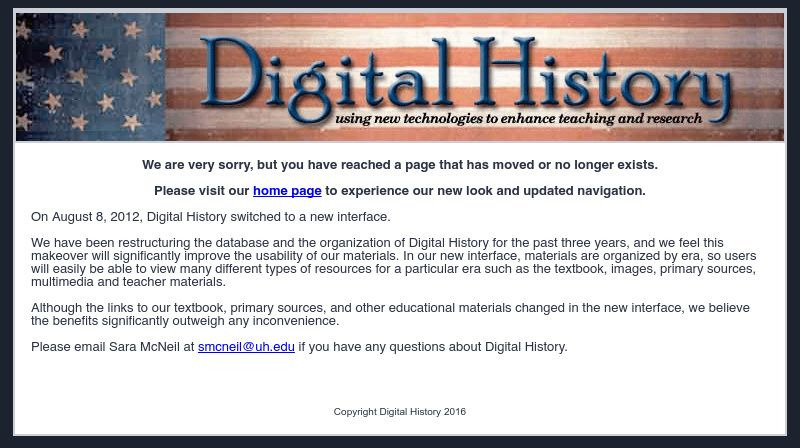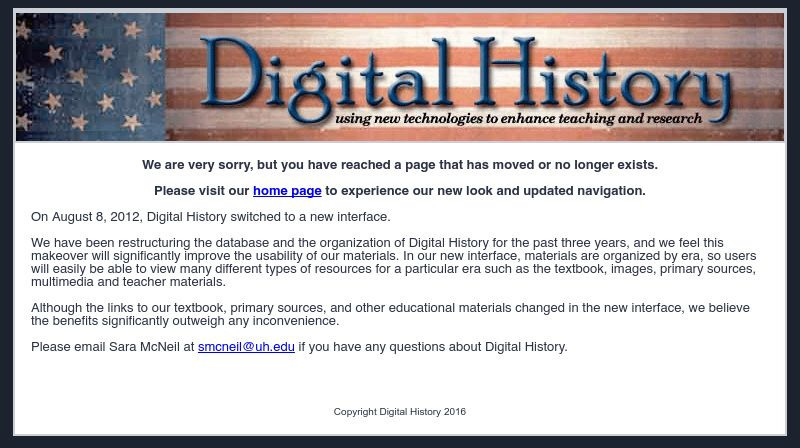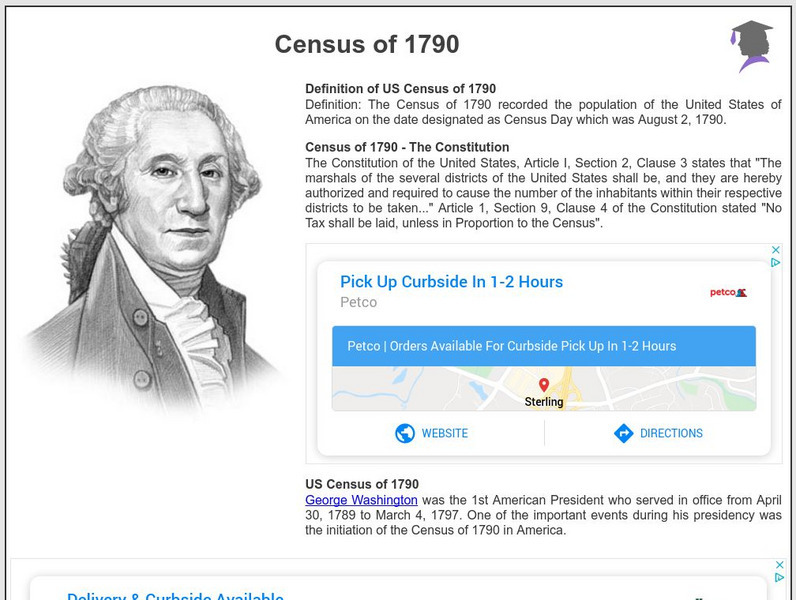Library of Congress
Loc: The New Nation 1783 1815
The creation and growth of the new nation of the United States is the focus of this article. Being divided into time periods makes this site easy to understand.
Georgia Department of Education
Ga Virtual Learning: Ap Us History: The Young Republic
AP U.S. History course module explores the young republic and an emerging new nation. Comprehensive multi-media learning materials.
Center For Civic Education
Center for Civic Education: How Constitution Used to Organize the New Govt [Pdf]
This lesson plan describes how, using the guidelines provided in the Constitution, the First Congress in April 1789 named the new president and vice president, provided funding for the new government, organized the executive branch,...
Tom Richey
Tom Richey: Jefferson vs. Hamilton (1789 1800)
Slideshows, lessons, primary sources, and videos present the United States during the final decade of the 18th century in the United States.
Other
The Colonial Williamsburg Foundation: Continuing Revolutions
America was victorious in the Revolutionary War, but now faced a slew of problems while trying to set up our new nation. Study how we attempted to solve the problems of establishing a government, forming our economy, meeting the needs of...
Library of Congress
Loc: America's Story: Isaiah Thomas' Printing
"A Curious Hieroglyphick Bible" is an historic example of one of the sixty-five children's books printed by Isaiah Thomas during the 1700s. Features a portrait of Thomas, a drawing of the Baptist Meeting House, and a sample of his...
Digital History
Digital History: The New Nation [Pdf]
Many problems existed for the new United States. Read about issues facing George Washington as the new President, and find out about the major successes of the first Congress. [PDF]
University of Groningen
American History: Outlines: New Nation's Economy
The U.S. Constitution, adopted in 1787 and still in effect to this day, was in many ways a work of creative genius. As an economic charter, it established that the entire nation -- stretching from Maine to Georgia, from the Atlantic...
Digital History
Digital History: The Formative Decade
The first decade of the new American nation saw much development and progress, but there was still contention about what the national government's role would be. Read about the differing views of Thomas Jefferson and Alexander Hamilton.
Digital History
Digital History: The First National Census
An interesting look at the difficulty of conducting the first national census in 1790. Find a snap shot of American society in that year and a glimpse of what the future held.
Digital History
Digital History: Challenges Facing the Nation
The new United States had no blueprint to follow in establishing a new democratic government. Read about the challenges facing the new nation, and how it dealt with ways to make the government work.
Digital History
Digital History: Conclusion
A brief account of the death of George Washington and a review of the great strides the country made in the decade beginning when he became president.
Gilder Lehrman Institute of American History
Gilder Lehrman Institute: History Now: The Early Republic
[Free Registration/Login Required] Read about the tremendous growing pains faced by the new republic of the United States from the presidency of George Washington up to the election of Thomas Jefferson. Find out about the domestic...
Khan Academy
Khan Academy: Us History: 1754 1800: Shaping a New Republic
A quick comprehension check over the shaping of the New Republic in the US between 1754-1800.
Khan Academy
Khan Academy: Us History: 1754 1800: Movement in the Early Republic
A quick comprehension check over movement in the early republic.
iCivics
I Civics: Nationbuilder in Chief
Learners learn about some of the decisions and actions the first presidential administrations took to make sure the United States would be strong enough to last.
Siteseen
Siteseen: American Historama: Census of 1790
Comprehensive resource provides facts about the First Census of 1790. This law found out how many people there were in each state which had an impact on Congressional apportionment.



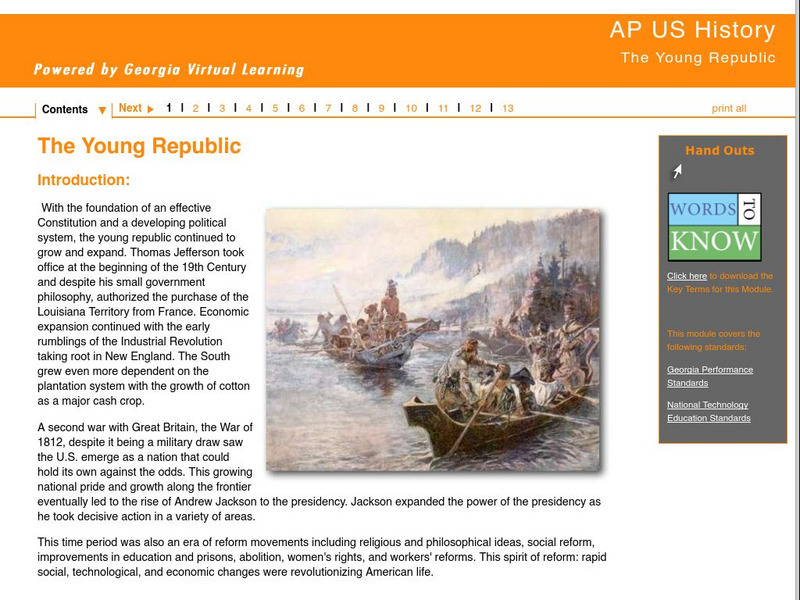
![Center for Civic Education: How Constitution Used to Organize the New Govt [Pdf] Lesson Plan Center for Civic Education: How Constitution Used to Organize the New Govt [Pdf] Lesson Plan](https://d15y2dacu3jp90.cloudfront.net/images/attachment_defaults/resource/large/FPO-knovation.png)


